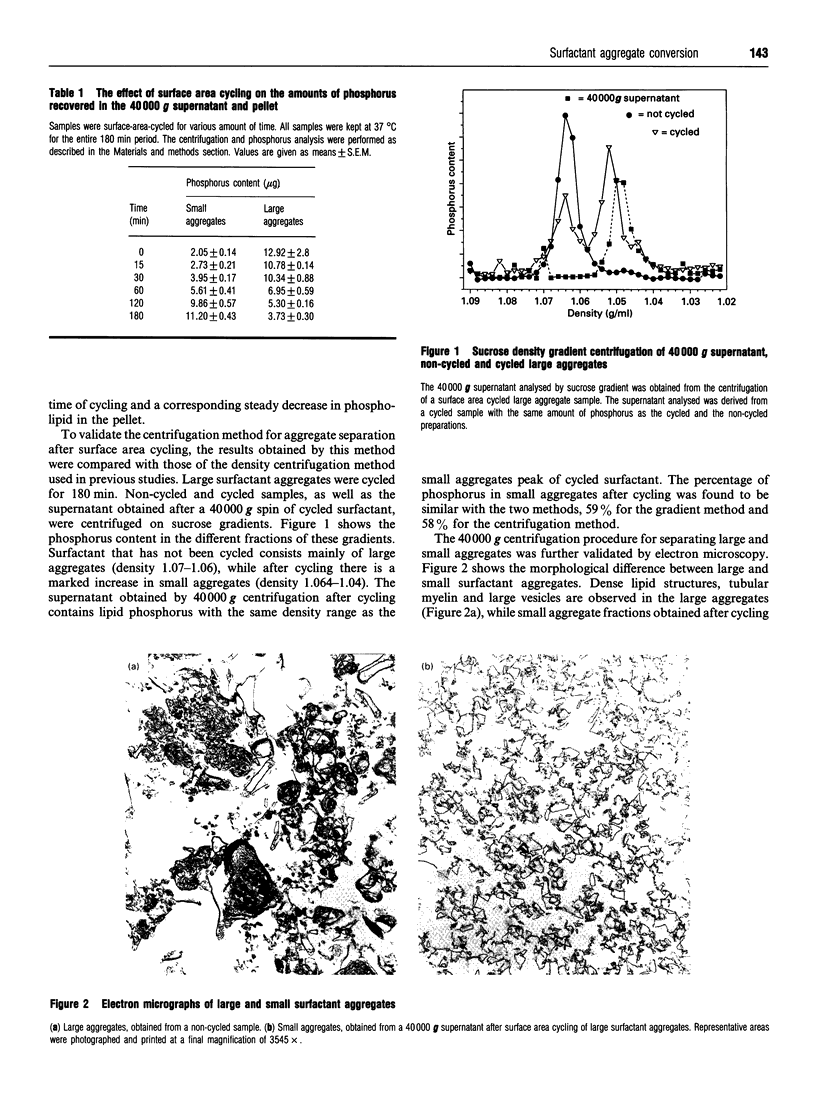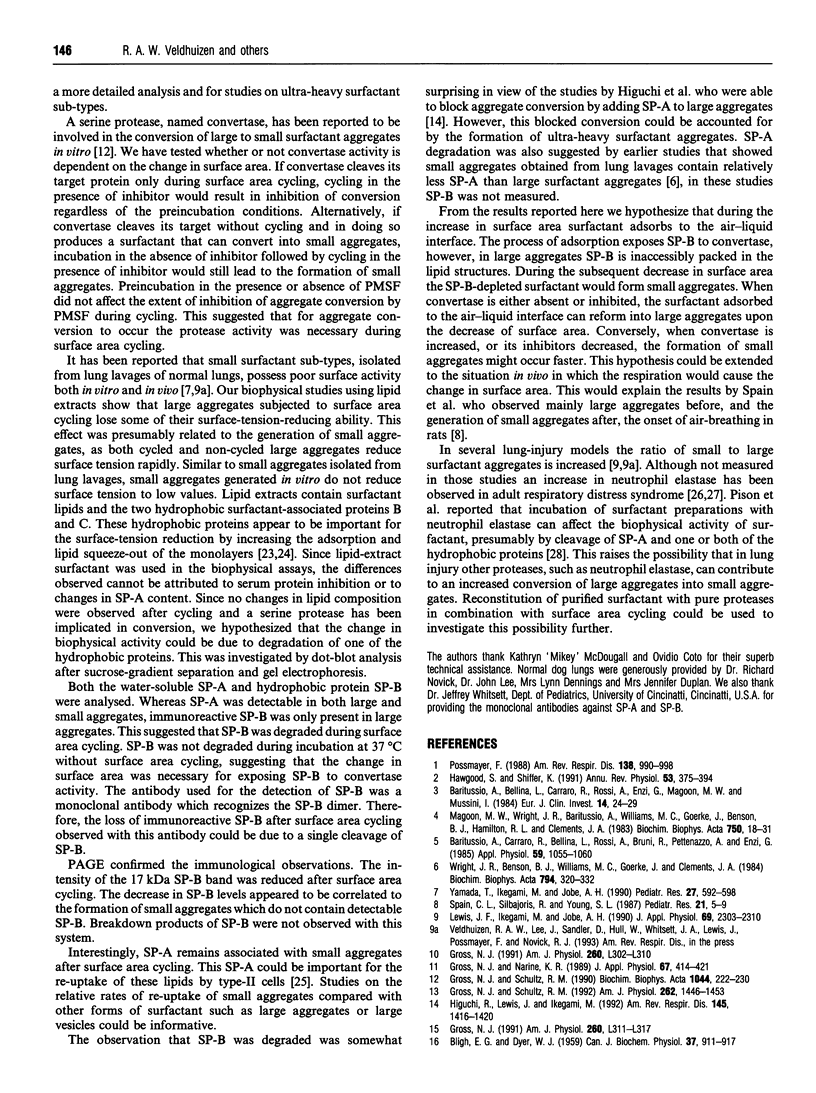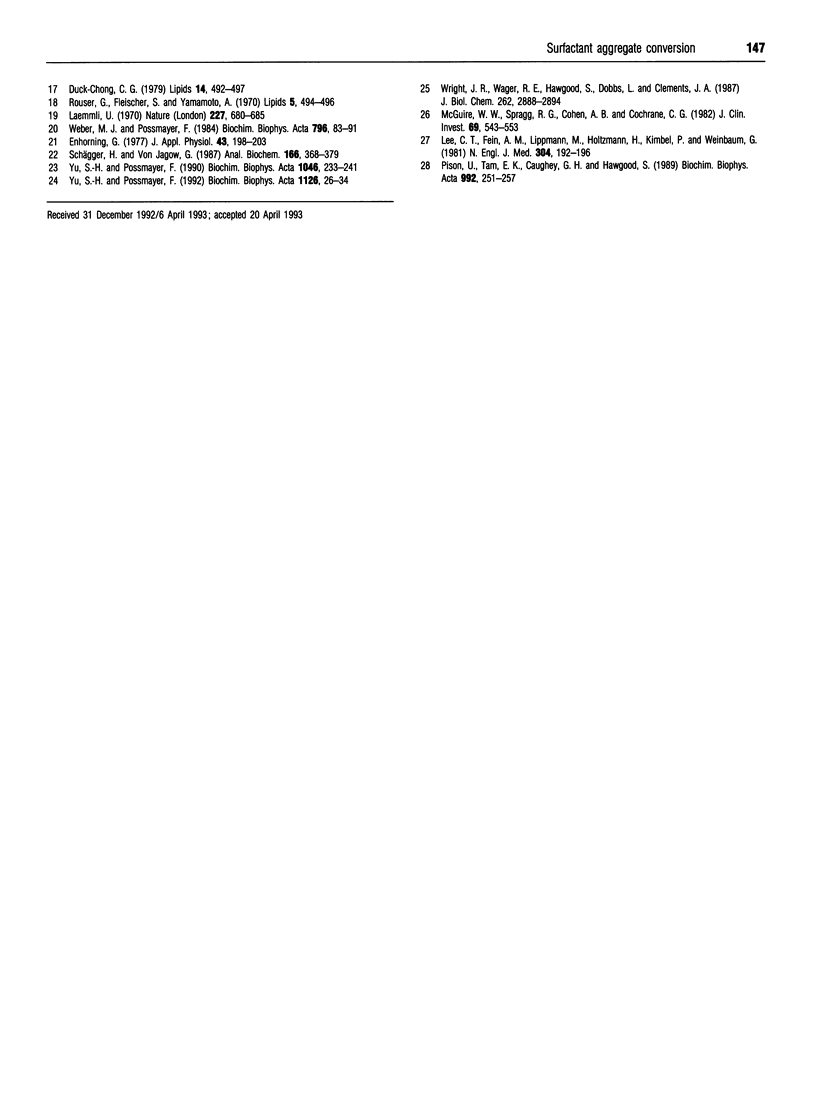Abstract
Pulmonary surfactant obtained from lung lavages can be separated by differential centrifugation into two distinct subfractions known as large surfactant aggregates and small surfactant aggregates. The large-aggregate fraction is the precursor of the small-aggregate fraction. The ratio of the small non-surface-active to large surface-active surfactant aggregates increases after birth and in several types of lung injury. We have utilized an in vitro system, surface area cycling, to study the conversion of large into small aggregates. Small aggregates generated by surface area cycling were separated from large aggregates by centrifugation at 40,000 g for 15 min rather than by the normal sucrose gradient centrifugation. This new separation method was validated by morphological studies. Surface-tension-reducing activity of total surfactant extracts, as measured with a pulsating-bubble surfactometer, was impaired after surface area cycling. This impairment was related to the generation of small aggregates. Immunoblot analysis of large and small aggregates separated by sucrose gradient centrifugation revealed the presence of detectable amounts of surfactant-associated protein B (SP-B) in large aggregates but not in small aggregates. SP-A was detectable in both large and small aggregates. PAGE of cycled and non-cycled surfactant showed a reduction in SP-B after surface area cycling. We conclude that SP-B is degraded during the formation of small aggregates in vitro and that a change in surface area appears to be necessary for exposing SP-B to protease activity.
Full text
PDF






Images in this article
Selected References
These references are in PubMed. This may not be the complete list of references from this article.
- BLIGH E. G., DYER W. J. A rapid method of total lipid extraction and purification. Can J Biochem Physiol. 1959 Aug;37(8):911–917. doi: 10.1139/o59-099. [DOI] [PubMed] [Google Scholar]
- Baritussio A., Bellina L., Carraro R., Rossi A., Enzi G., Magoon M. W., Mussini I. Heterogeneity of alveolar surfactant in the rabbit: composition, morphology, and labelling of subfractions isolated by centrifugation of lung lavage. Eur J Clin Invest. 1984 Feb;14(1):24–29. doi: 10.1111/j.1365-2362.1984.tb00699.x. [DOI] [PubMed] [Google Scholar]
- Baritussio A., Carraro R., Bellina L., Rossi A., Bruni R., Pettenazzo A., Enzi G. Turnover of phospholipids isolated from fractions of lung lavage fluid. J Appl Physiol (1985) 1985 Oct;59(4):1055–1060. doi: 10.1152/jappl.1985.59.4.1055. [DOI] [PubMed] [Google Scholar]
- Enhorning G. Pulsating bubble technique for evaluating pulmonary surfactant. J Appl Physiol Respir Environ Exerc Physiol. 1977 Aug;43(2):198–203. doi: 10.1152/jappl.1977.43.2.198. [DOI] [PubMed] [Google Scholar]
- Gross N. J. Inhibition of surfactant subtype convertase in radiation model of adult respiratory distress syndrome. Am J Physiol. 1991 Apr;260(4 Pt 1):L311–L317. doi: 10.1152/ajplung.1991.260.4.L311. [DOI] [PubMed] [Google Scholar]
- Gross N. J., Narine K. R. Surfactant subtypes of mice: metabolic relationships and conversion in vitro. J Appl Physiol (1985) 1989 Jul;67(1):414–421. doi: 10.1152/jappl.1989.67.1.414. [DOI] [PubMed] [Google Scholar]
- Gross N. J., Schultz R. M. Serine proteinase requirement for the extra-cellular metabolism of pulmonary surfactant. Biochim Biophys Acta. 1990 May 22;1044(2):222–230. doi: 10.1016/0005-2760(90)90306-i. [DOI] [PubMed] [Google Scholar]
- Hawgood S., Shiffer K. Structures and properties of the surfactant-associated proteins. Annu Rev Physiol. 1991;53:375–394. doi: 10.1146/annurev.ph.53.030191.002111. [DOI] [PubMed] [Google Scholar]
- Higuchi R., Lewis J., Ikegami M. In vitro conversion of surfactant subtypes is altered in alveolar surfactant isolated from injured lungs. Am Rev Respir Dis. 1992 Jun;145(6):1416–1420. doi: 10.1164/ajrccm/145.6.1416. [DOI] [PubMed] [Google Scholar]
- Laemmli U. K. Cleavage of structural proteins during the assembly of the head of bacteriophage T4. Nature. 1970 Aug 15;227(5259):680–685. doi: 10.1038/227680a0. [DOI] [PubMed] [Google Scholar]
- Lee C. T., Fein A. M., Lippmann M., Holtzman H., Kimbel P., Weinbaum G. Elastolytic activity in pulmonary lavage fluid from patients with adult respiratory-distress syndrome. N Engl J Med. 1981 Jan 22;304(4):192–196. doi: 10.1056/NEJM198101223040402. [DOI] [PubMed] [Google Scholar]
- Lewis J. F., Ikegami M., Jobe A. H. Altered surfactant function and metabolism in rabbits with acute lung injury. J Appl Physiol (1985) 1990 Dec;69(6):2303–2310. doi: 10.1152/jappl.1990.69.6.2303. [DOI] [PubMed] [Google Scholar]
- Magoon M. W., Wright J. R., Baritussio A., Williams M. C., Goerke J., Benson B. J., Hamilton R. L., Clements J. A. Subfractionation of lung surfactant. Implications for metabolism and surface activity. Biochim Biophys Acta. 1983 Jan 7;750(1):18–31. doi: 10.1016/0005-2760(83)90200-x. [DOI] [PubMed] [Google Scholar]
- McGuire W. W., Spragg R. G., Cohen A. B., Cochrane C. G. Studies on the pathogenesis of the adult respiratory distress syndrome. J Clin Invest. 1982 Mar;69(3):543–553. doi: 10.1172/JCI110480. [DOI] [PMC free article] [PubMed] [Google Scholar]
- Pison U., Tam E. K., Caughey G. H., Hawgood S. Proteolytic inactivation of dog lung surfactant-associated proteins by neutrophil elastase. Biochim Biophys Acta. 1989 Sep 15;992(3):251–257. doi: 10.1016/0304-4165(89)90082-2. [DOI] [PubMed] [Google Scholar]
- Possmayer F. A proposed nomenclature for pulmonary surfactant-associated proteins. Am Rev Respir Dis. 1988 Oct;138(4):990–998. doi: 10.1164/ajrccm/138.4.990. [DOI] [PubMed] [Google Scholar]
- Rouser G., Fkeischer S., Yamamoto A. Two dimensional then layer chromatographic separation of polar lipids and determination of phospholipids by phosphorus analysis of spots. Lipids. 1970 May;5(5):494–496. doi: 10.1007/BF02531316. [DOI] [PubMed] [Google Scholar]
- Schägger H., von Jagow G. Tricine-sodium dodecyl sulfate-polyacrylamide gel electrophoresis for the separation of proteins in the range from 1 to 100 kDa. Anal Biochem. 1987 Nov 1;166(2):368–379. doi: 10.1016/0003-2697(87)90587-2. [DOI] [PubMed] [Google Scholar]
- Spain C. L., Silbajoris R., Young S. L. Alterations of surfactant pools in fetal and newborn rat lungs. Pediatr Res. 1987 Jan;21(1):5–9. doi: 10.1203/00006450-198701000-00002. [DOI] [PubMed] [Google Scholar]
- Weber M. J., Possmayer F. Calcium interactions in pulmonary surfactant. Biochim Biophys Acta. 1984 Oct 24;796(1):83–91. doi: 10.1016/0005-2760(84)90241-8. [DOI] [PubMed] [Google Scholar]
- Wright J. R., Benson B. J., Williams M. C., Goerke J., Clements J. A. Protein composition of rabbit alveolar surfactant subfractions. Biochim Biophys Acta. 1984 Dec 21;791(3):320–332. doi: 10.1016/0167-4838(84)90343-1. [DOI] [PubMed] [Google Scholar]
- Wright J. R., Wager R. E., Hawgood S., Dobbs L., Clements J. A. Surfactant apoprotein Mr = 26,000-36,000 enhances uptake of liposomes by type II cells. J Biol Chem. 1987 Feb 25;262(6):2888–2894. [PubMed] [Google Scholar]
- Yu S. H., Possmayer F. Effect of pulmonary surfactant protein B (SP-B) and calcium on phospholipid adsorption and squeeze-out of phosphatidylglycerol from binary phospholipid monolayers containing dipalmitoylphosphatidylcholine. Biochim Biophys Acta. 1992 Jun 5;1126(1):26–34. doi: 10.1016/0005-2760(92)90212-e. [DOI] [PubMed] [Google Scholar]
- Yu S. H., Possmayer F. Role of bovine pulmonary surfactant-associated proteins in the surface-active property of phospholipid mixtures. Biochim Biophys Acta. 1990 Oct 1;1046(3):233–241. doi: 10.1016/0005-2760(90)90236-q. [DOI] [PubMed] [Google Scholar]






